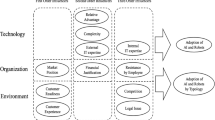Abstract
Industrial robots have become a vital part of automation in industries performing operations like stacking, casting, painting, sorting, welding etc. The basic sensory abilities in most cases needs operating these robots inside robot fences which separate the operator from the robot. But now this line of separation is becoming thin and work environments are being designed for collaborative tasks involving both human and robot participation. This transformation demands for systems that ensure the safety of the operator inside the work environment. We have designed and implemented a new localization method for the industrial robot environments using RFID technology. The entire system is implemented as a ROS based package to facilitate integration and experimentation in broad range of robot architectures. We have also developed a real time 3D visualization of the monitored work environment in RViz for displaying sensor data and state information from ROS. The system provides good real time response and proves to be a cost efficient and scalable method for human localization in robot-cells.







Similar content being viewed by others
References
Taghirad HD (2013) Parallel robots: mechanics and control. CRC Press, Boca Raton
Bascetta L et al (2011) Towards safe human–robot interaction in robotic cells: an approach based on visual tracking and intention estimation. In: 2011 IEEE/RSJ international conference on intelligent robots and systems (IROS). IEEE
Zhang W, Sobh TM (2003) Obstacle avoidance for manipulators. Syst Anal Model Simul 43(6):749–757
Munasinghe SR, Nakamura M, Goto S, Kyura N (2003) Trajectory planning for industrial robot manipulators considering assigned velocity and allowance under joint acceleration limit. Int J Control Autom Syst 1(1):68–75
Hayes B, Scassellati B (2012) Challenges in shared-environment human–robot collaboration. In: Tech IM (ed) Human machine interaction getting closer. Rijeka, pp 213–234
Graham JH, Meagher JF, Derby SJ (1986) A safety and collision avoidance system for industrial robots. IEEE Trans Ind Appl 1:195–203
Lasota PA, Rossano GF, Shah JA (2007) Toward safe close-proximity human–robot interaction with standard industrial robots. In: Proceedings of the ACM/IEEE international conference on human–robot interaction. ACM, pp 255–262
Rowaihy H, Eswaran S, Johnson M, Verma D, Bar-Noy A, Brown T, La Porta T (2007) A survey of sensor selection schemes in wireless sensor networks. In: Proceedings of the SPIE, vol 6562, Unattended ground, sea, and air sensor technologies and applications IX, 65621A (May 11, 2007). doi:10.1117/12.723514
Want R, Hopper A, Falcao V, Gibbons J (1992) The active badge location system. ACM Trans Inf Syst 40(1):91–102
Hazas M, Hopper A (2006) A novel broadband ultrasonic location system for improved indoor positioning. IEEE Trans Mob Comput 5(5):536–547
Fukuju Y, Minami M, Morikawa H, Aoyama T (2003) Dolphin: an autonomous indoor positioning system in ubiquitous computing environment. In: Proceedings of the IEEE workshop on software technologies for future embedded systems. IEEE, pp 53–56
Minami M, Fukuju Y, Hirasawa K, Yokoyama S, Mizumachi M, Morikawa H, Aoyama T (2004) Dolphin: a practical approach for implementing a fully distributed indoor ultrasonic positioning system. In: Ubicomp 2004: Ubiquitous Computing, pp 347–365
Priyantha NB (June 2005) The cricket indoor location system. PhD thesis, Massachusetts Institute of Technology, p 199
Argall BD, Billard AG (2010) A survey of tactile human–robot interactions. Robot Auto Syst 58(10):1159–1176
Fritzsche M, Elkmann N, Schulenburg E (2011) Tactile sensing: a key technology for safe physical human robot interaction. In: 2011 6th ACM/IEEE international conference human–robot interaction (HRI), pp 139–140
Bascetta L, Ferretti G, Rocco P (2011) Towards safe human robot interaction in robotic cells: an approach based on visual tracking and intention estimation. In: 2011 IEEE/RSJ international conference on intelligent robots and systems. San Francisco, Sept 25–30
Ni LM, Liu Y, Lau IC, Patil AP (2003) LANDMARC: indoor location sensing using active RFID. In: Pervasive computing and communications (PerCom 2003)
Hekimian-Williams C, Grant B, Liu X, Zhang Z, Kumar P (2010) Accurate localization of RFID tags using phase difference. In: 2010 IEEE international conference on RFID (IEEE RFID 2010). IEEE, Orlando, Florida, pp 89–96
Athalye A, Savic V, Bolic M, Djuric PM (2007) A novel semi-passive RFID system for indoor localization. In: Proceedings of the European conference on mobile robots, pp 241–246
Zhao Y, Liu Y, Ni LM (2007) VIRE: Active RFID based localization using virtual reference elimination. In: 2007 international conference on parallel processing. IEEE, p 56
Acknowledgements
Our gratitude goes to Sri Mata Amritanandamayi Devi, world renowned humanitarian and the Chancellor of Amrita Vishwa Vidyapeetham for providing the inspiration to successfully complete this project. The authors would like to thank Dr. Kurien Issac and Dr. Radhamani V. Pillay for their valuable suggestions in various stages of this work. We also thank Akshay Nagarajan and Vishnu Rajendran for the guidance in documenting the work.
Author information
Authors and Affiliations
Corresponding author
Rights and permissions
About this article
Cite this article
Krishna, S., Rahul, E.S. & Bhavani, R.R. RFID based-human localization in robot-cells for a better shared workspace interaction. CSIT 4, 37–43 (2016). https://doi.org/10.1007/s40012-016-0084-1
Received:
Accepted:
Published:
Issue Date:
DOI: https://doi.org/10.1007/s40012-016-0084-1




